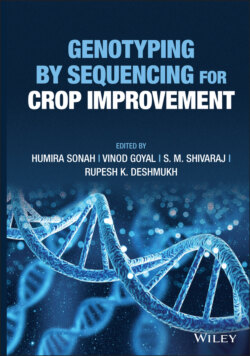Читать книгу Genotyping by Sequencing for Crop Improvement - Группа авторов - Страница 68
3.5 Pinpointing Gene Through Whole‐Genome Resequencing‐based QTL Mapping
ОглавлениеThe NGS has been used for QTL mapping and pinpointing the genes of interest. QTL mapping approaches solve the issues caused by repetitive sequences and genome duplication in addition to combining SNP discovery, SNP validation, and genotyping (Xu et al. 2013). Huang et al. (2009) showed that QTL affecting plant height were linked to a region where the green revolution gene is situated (Huang et al. 2009; Xu et al. 2013). Rice recombinant inbred lines (RIL) populations were genotyped with the help of WGR (Huang et al. 2009). In rice, QTL mapping precision for grain width was evaluated from previously cloned QTL possessing the gene GW5 for grain width found to be localized in bin, its presumed genomic location (Xie et al. 2010). The complexity of the genome of some species for example soybean (paleopolyploid) hinders the applications of sequencing‐based genotyping approaches. Since, due to two genome duplication events, 75% of the genes are present in multiple copies (Schmutz et al. 2010). These paralogs further pose issues due to the short sequence reads which cause undistinguished allelic variations. Besides, the abundant repetitive sequences, heterochromatic regions of soybean genome, provide technological challenges for sequence alignment. Using 246 RILs sequenced at an average depth of 0.19× (Xu et al. 2013). Using 246 RILs sequenced at an average depth of 0.19, Xu et al. (2013) employed NGS methods to find QTL for southern root‐knot nematode (RKN) resistance in soybean. They identified and validated SNPs. RIL population was genotyped as well as the parental source of each SNP allele was deduced. Linkage map was subsequently established using 3509 bins and 3489 recombination intervals as molecular markers. Out of three QTLs identified, one major QTL was 29.7 kb in size and mapped to bin 10 of chromosome 10. This QTL possess three true and two pseudogenes. As a result of sequence differences and gene expression analyses, the RKN resistance candidate genes Glyma10g02160 and Glyma10g02150 were identified which encodes for pectin methylesterase inhibitor‐pectin methylesterase and pectin methylesterase inhibitor, respectively. This method is widely used to enhance QTL mapping accuracy in crops with a reference genome.
